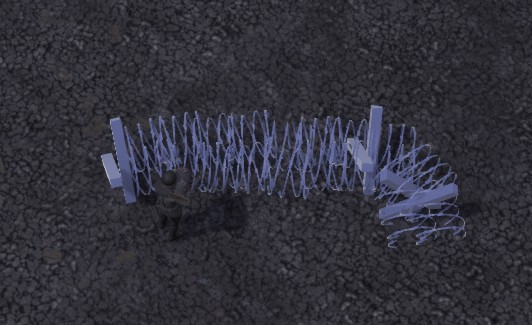Barbed Wire (Structure)
| This article is about the Barbed Wire structure that's placed in the world. For the Large Material of the same name, see Barbed Wire (Material). |
| “ | Used to slow down enemy infantry movement. Can be dismantled with a Wrench. | „ |
| — In-game description |
Barbed Wire is an anti-infantry obstacle that drastically reduces both friendly and enemy infantry movement. It does not affect vehicles in any way. The only way to remove it is to dismantle it with a Wrench, or a Hydra's Whisper.
Construction
They are built with 3 barbed wire materials.
Grab a barbed wire material and press B to open the build menu. Select the Barbed Wire structure option, then press LMB to place the first end of the blueprint and RMB to rotate it, then move your mouse to change the length of the structure and RMB to curve it and press LMB to place the other end. A blueprint will spawn, submit the barbed wire on your shoulder into it by pressing LMB. Submit two more to finish the construction
The length of one Barbed Wire structure is between 4 and 10 meters. Since cost doesn't scale with length it's preferable to always build them with the maximum length allowed (10m).
It can be built on beaches, large bridges, roads, and on the paved areas inside large towns.
Placement
When placing barbed wire, it's important to remember that it hinders both friendly and enemy movement and should generally only be put in areas that the enemy will want to move through but your team will not. For example, you could place it on the far side of Sandbags to deny the enemy the ability to use it as cover from your direction of fire.
Tactics
Barbed wire is an obstacle to friend and foe alike, and due to this property it is the subject of mixed opinions. Defence-minded players appreciate its ability to block off alleyways and narrow gaps, to hinder movement through areas of concealment, or to force enemy attacks to run headlong into AI defences or machine guns. Offence-minded players find it limiting to counter-attacking the enemy as it often blocks off the most direct route to the enemy. As lengthening the march to the enemy reduces offensive pressure, an impermeable wall of wire is undesirable.
Wire should be therefore be built as a means of controlling, not stopping, movement.
A barbed wire screen is a perimeter of wire on the enemy's likely or known axis of approach. Wire should, save for the "assault lane" mentioned below, be spaced tightly enough the enemy cannot pass through without almost certainly snagging the wire and being slowed. Ideally, wire screens keep the enemy out of range for throwing HE grenades at your foxholes and trenches. At night or in bad weather, vision is drastically reduced and a wire screen too far forward may be obscured. If the enemy can crawl through the wire undetected, it has created a false sense of security and may be worse than no wire at all.
Barbed wire screens must, with no exceptions, contain an obvious "assault lane" for friendly troops to use when retaking the offensive. These should be comfortably spaced for friendlies to pass through without scraping the wire yet still force the enemy to run headlong into direct fire with little space to evade. An example is section of wire missing from the screen and replaced by two wire sections forming a funnel away from one of your stronger firing positions. The gap should be clear of concealment on the friendly side to prevent the enemy's easy infiltration. Lane exits should never be under enemy fire, and should always be wider facing the enemy to give your forces more space to evade. Do not build zig-zags; they will frustrate friendly forces trying to leave and encourage the enemy to evade defensive fire.
Barbed wire should be placed where the enemy will be under fire while attempting to dismantle it. AI foxholes are good for this purpose, as are garrison bunkers. In active sectors, trench lines and bunkers with firing ports can provide the most potential firepower of all, but only so long as the engagement lasts. Objects blocking vision, including the common sandbag/wire combination, create a weak point where the enemy can remove your wire and then seize the piece of cover.
To this end, tank traps and wire should not be built together. Wire is useful to separate aggressive tanks from their supporting infantry. Once beyond the wire, tank traps and mines are to keep tanks from advancing.
In urban areas, wire can be built to partially or completely block streets and alleyways with relative ease. Care should be taken that the approaches your side will use to enter a house remain open to your spawn points while the enemy has to pass through wire to reach their door. The idea of assault lanes can still be practised with passable gaps to the enemy in places always kept under fire. Wire at an angle from a building corner can force the enemy to run into the middle of a crossroad and easily shot.
Notes
- Barbed wire blueprints which have been placed but not completed will stop vehicles.
Gallery
| |||||||||||||||||||||||||||||||||||||||||||||||||||||||||||||||||||||||||||||||||||||||||||||||||||



